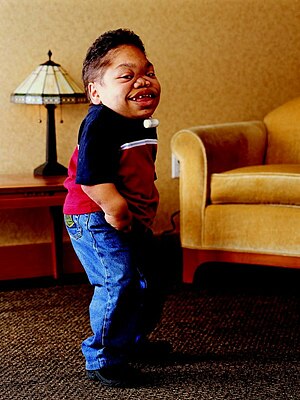Coarse facial features
Coarse facial features or coarse facies describes a constellation of facial features that are present in many inborn errors of metabolism.[1]
| Coarse facies | |
|---|---|
 | |
| A 16 year old with Mucopolysaccharidosis showing coarse facial features. | |
| Specialty | Medical genetics |
Features include:[1]
- large, bulging head
- prominent scalp veins
- "saddle-like, flat bridged nose with broad, fleshy tip"
- large lips and tongue
- small, widely spaced and/or malformed teeth
- hypertrophic alveolar ridges and/or gums
Heads tend to be longer than normal from front to back, with a bulging forehead. This is because of the earlier than normal or premature fusion of skull bones in an affected individual.
Causes[]
Several conditions are associated with coarse facial features.[2]
- Acromegaly
- Aspartylglycosaminuria
- Borjeson Syndrome
- Congenital hypothyroidism
- Fucosidosis type 1
- GM1 gangliosidosis
- Hyper IgE
- Hypomelanosis of Ito
- I cell disease
- Infantile sialic acid storage disorder
- Job syndrome
- McCune-Albright Syndrome
- Morquio syndrome
- Mucolipidosis III
- Mucopolysaccharidosis type 2 Hunter syndrome- mild form
- Mucopolysaccharidosis type 2 Hunter syndrome- severe form
- Mucopolysaccharidosis type 3
- Mucopolysaccharidosis type 6
- Mucopolysaccharidosis type I Hurler syndrome
- Mucopolysaccharidosis type I Hurler/Scheie syndrome
- Mucopolysaccharidosis type I Scheie syndrome
- Multiple endocrine neoplasia type 2b
- Nodulosis-arthropathy-osteolysis syndrome
- Sialuria syndrome
- Simpson-Golabi-Behmel syndrome
- Winchester syndrome
See also[]
References[]
- ^ a b Kagalwala, T. Y.; Bharucha, B. A.; Khare, R. D.; Kumta, N. B. (1 November 1988). "Diagnostic approach to coarse facies". The Indian Journal of Pediatrics. 55 (6): 861–870. doi:10.1007/BF02727817. PMID 3235137. S2CID 27241573.
- ^ "Causes of Coarse facial features". WrongDiagnosis.com. 18 November 2010. Retrieved 3 January 2011.
External links[]
- https://web.archive.org/web/20090106211640/http://www.mps1disease.com/patient/about/mps_pt_symptom_coarse_facial_features.asp
- http://www.wrongdiagnosis.com/
Categories:
- Facial features
- Symptom stubs